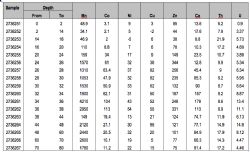 Targets WA Desert For Meteorite Impact Mineral Deposits
Targets WA Desert For Meteorite Impact Mineral Deposits
Sydney, June 11, 2015 AEST (ABN Newswire) - ASX listed Strategic Elements ( ASX:SOR) will fund exploration of two projects covering potential impact structures caused by meteorites striking the Great Victoria Desert over a hundred million years ago. Meteorite impact structures potentially contain mineral deposits (e.g. copper, nickel, uranium, gold, diamonds) due to the enormous energy, heat and pressure created by the impact.
ASX:SOR) will fund exploration of two projects covering potential impact structures caused by meteorites striking the Great Victoria Desert over a hundred million years ago. Meteorite impact structures potentially contain mineral deposits (e.g. copper, nickel, uranium, gold, diamonds) due to the enormous energy, heat and pressure created by the impact.
The projects were generated in collaboration between 100% owned Maria Resources and Dr Franco Pirajno, one of Western Australia's most respected geologists. As well as fieldwork on impact structures Dr Pirajno has published a book on hydrothermal processes and mineral systems including impact structures and written several peer reviewed papers on impact structures.
Company Comment
Managing Director Charles Murphy said, "Although the memory technology project is front and centre it is important for investors to remember there is more potential value in the Company. The two new projects are a fantastic addition by Dr Pirajno and the team and they could provide large scale upside for the Company as a whole".
Impact Structures
Meteorite impact is an extraordinary planetary process involving vast amounts of energy and extreme stress strain rates, causing immediate rises in pressure that produce fracturing, disruption and structural re-distribution of target materials.
Although not widely known in Australia as targets for exploration, meteorite impact structures are well recognised overseas to be associated with significant mineral resources. One of the most prominent deposits related to impact are gold deposits of the Witwatersrand Basin, which has produced approx. 40% of all gold mined on Earth.
The world class Nickel Copper Sulphide deposits in mafic ultramafic intrusions of the large Sudbury impact structure are also prominent. However there are numerous other deposits (Carswell Uranium, Ternovka Iron Ore-Uranium etc.) that are linked with impact structures.
The largest Zinc mine in Australia (Century Mine) was located directly adjacent to the Lawn Hill Impact Structure, although there is debate over the exact relationship. It is reported that impact structures in excess of 5-10km diameters represent potential exploration targets.
Lennis Project - Great Victoria Desert, WA
The Lennis Project covers 362 km2 of ground lodged in the Great Victoria Desert over a potential meteorite impact structure and affected surrounding area. According to meteorite impact experts Iasky and Glikson, Lennis has a 20km diameter multi-ringed magnetic anomaly with the characteristics of a meteorite impact structure.
Imperial College calculations based on diameter predict that the potential meteorite was travelling at 17 kilometres per second producing energy roughly equivalent to 6780 mega tonnes of TNT, over six times more than the largest earthquake in history.
Lennis Project - Highly Prospective for Mafic-Ultramafic Magmatic Sulphides
Lennis is highly prospective for nickel-copper-platinum in massive sulphides due to a distinctive, strong positive gravity anomaly located within the potential impact structure.
Geoscience Australia interpreted multiple intrusions of the Albany Fraser Orogeny in the area around Lennis. Albany Fraser mafic-ultramafic intrusions are well known to the market from the outstanding success of Sirius Resources and their rich Nova deposit. The nature of the gravity anomaly at Lennis is consistent with a mafic-ultramafic intrusion or area of dense alteration.
The gravity anomaly at Lennis is adjacent to the centre of the potential impact structure and is interpreted as an intrusive unit that may have been uplifted closer to surface during the Lennis impact event. It is notable that at the Carswell Impact Structure (Canada) uranium ore was reportedly uplifted by 2km. Notably world-class deposits of nickel copper sulphides occur in maficultramafic intrusions at the Sudbury Impact Structure.
Lennis Project - Prospective for Hydrothermal Vein Mineralisation
Only one Company (CRA, 1992) has explored the area, however they did not report an impact structure and positioned their 5 drill holes aimed at exploring for diamonds. The gravity anomaly and most of the Lennis project were not tested in drilling for impact related deposits.
The heat energy produced by the impact results in the circulation of hydrothermal fluids capable of carrying ore minerals.
Analysis of CRA data from drill hole 90RCLE002 revealed 56m of highly anomalous manganese from 24m to the bottom of the hole at 80m (see table in link below).
The consistent manganese indicates a heat driven hydrothermal system exists within the potential impact structure and increases the prospect of metals (base metals, cobalt, gold, manganese) being present in hydrothermal veins.
Lennis Project - Other Hydrothermal Related Mineralisation
There is potential for Uranium mineralisation in black bitumen nodules within Lennis such as those reported at the Krivoy Rog impact structure5 (Ukraine).
Some evidence of this exists at Lennis in CRA drill hole 90RCLE002 where anomalous Uranium, Cerium and Thorium values (see table in link below) are associated with an "unidentified black mineral".
Ilkurka Project - Great Victoria Desert, WA
The second project called Ilkurka (ilkurka) covers 120 km2 of ground lodged in the Great Victoria Desert over a potential meteorite impact structure and affected surrounding area. Ilkurka is approx.
80km southeast of the Lennis project. As reported by Iasky and Glikson, Ilkurka displays a 15km diameter magnetic anomaly with the characteristics of a meteorite impact structure.
As with Lennis, Geoscience Australia interpreted multiple intrusions of the Albany Fraser Orogeny in the area around Ilkurka. However there is no relevant gravity survey available and there has been no drilling. CRA conducted ground magnetics for diamonds but decided against drilling.
Dr Franco Pirajno visited Ilkurka in 2004 on a solo expedition across several WA Deserts whilst he was a Senior Geoscientist in the Geological Survey of Western Australia. He found it covered by sediments and no sampling was conducted.
As Ilkurka is unexplored and covered by sediments at surface there is no published data relating to the potential impact structure.
Ilkurka is a totally untested potential meteorite impact structure situated in a favourable location for mafic-ultramafic related nickel-copper-platinum and 100% owned Maria Resources intends to be the first explorer to drill into it.
The conceptual model (in link below) from Grieve was modified by Dr Franco Pirajno to show an uplifted mafic-ultramafic intrusive to be targeted for magmatic sulphides containing nickel-copper-platinum.
It also shows potential hydrothermal related areas to be targeted for base metals, cobalt, gold and uranium.
The existing gravity anomaly at Lennis is the priority target for drilling. However it is possible that smaller, shallower, higher density bodies / zones may be present but were not identified or defined by the existing wide spaced gravity readings.
360km2 of ground has been applied for covering the Lennis project and 120km2 of ground covering the Ilkurka project. It is intended for the first work program to include a detailed gravity survey at Lennis and an initial wider spaced survey at Ilkurka to uncover anomalies to be followed up with drilling.
About Maria Resources
Maria Resources is collaborating with world leading geologist Dr Franco Pirajno to explore Western Australia for mineral systems and models more commonly found overseas.
Maria Resources initial project in the Gibson and Great Victoria Deserts is seeking a style of copper-silver-cobalt known in central-eastern Europe as Kupferschiefer (PKS) that are the second most important style of copper deposits in the world. The Officer Project has applied for over 700km2 of unexplored ground with over 190km of outcrop for low cost and effective sampling.
Highly anomalous copper in several historic drill holes drilled 8 km apart with all the hallmarks of PKS provide a clear exploration focus. ?Discovery from overseas models in WA frontiers'.
Maria Resources has just announced the addition of the Lennis and Ilkurka projects, which will target potential meteorite impact structure related mineralisation in the Great Victoria Desert. Both projects potentially have uplifted Albany Fraser Orogeny mafic-ultramafic intrusives to be targeted for magmatic sulphides containing nickel-copper-platinum. Further potential for hydrothermal related base metals, cobalt, gold and uranium also exists.
About Strategic Elements
Strategic Elements is a unique vehicle listed under the code "SOR" on the Australian Stock Exchange and has a dual resources and technology exposure. In the technology sector the Company has recently agreed to back a revolutionary memory technology developed at the University of NSW.
Strategic Elements is registered by the Australian Federal Government under a special program to encourage investment into Australian SME's. The Company's registration as a Pooled Development Fund provides most shareholders with tax-free capital gains when they sell their shares and tax-free dividends.
To view figures and table data, please visit:
http://media.abnnewswire.net/media/en/docs/ASX-SOR-722211.pdf
About Strategic Elements Ltd
 Strategic Elements (ASX:SOR) shares are listed on the Australian Stock Exchange under the code “SOR”. The Company is registered under the Pooled Development Program run by the Australian Federal Government to encourage investment into SME’s. To assist Pooled Development Fund’s to invest and raise capital, the Federal Government enables most shareholders in a Pooled Development Fund to make capital gains and receive dividends tax-free.
Strategic Elements (ASX:SOR) shares are listed on the Australian Stock Exchange under the code “SOR”. The Company is registered under the Pooled Development Program run by the Australian Federal Government to encourage investment into SME’s. To assist Pooled Development Fund’s to invest and raise capital, the Federal Government enables most shareholders in a Pooled Development Fund to make capital gains and receive dividends tax-free.
![abnnewswire.com]()
Related Companies
Social Media
Share this Article

 ASX:SOR) will fund exploration of two projects covering potential impact structures caused by meteorites striking the Great Victoria Desert over a hundred million years ago. Meteorite impact structures potentially contain mineral deposits (e.g. copper, nickel, uranium, gold, diamonds) due to the enormous energy, heat and pressure created by the impact.
ASX:SOR) will fund exploration of two projects covering potential impact structures caused by meteorites striking the Great Victoria Desert over a hundred million years ago. Meteorite impact structures potentially contain mineral deposits (e.g. copper, nickel, uranium, gold, diamonds) due to the enormous energy, heat and pressure created by the impact. Strategic Elements (ASX:SOR) shares are listed on the Australian Stock Exchange under the code “SOR”. The Company is registered under the Pooled Development Program run by the Australian Federal Government to encourage investment into SME’s. To assist Pooled Development Fund’s to invest and raise capital, the Federal Government enables most shareholders in a Pooled Development Fund to make capital gains and receive dividends tax-free.
Strategic Elements (ASX:SOR) shares are listed on the Australian Stock Exchange under the code “SOR”. The Company is registered under the Pooled Development Program run by the Australian Federal Government to encourage investment into SME’s. To assist Pooled Development Fund’s to invest and raise capital, the Federal Government enables most shareholders in a Pooled Development Fund to make capital gains and receive dividends tax-free.











